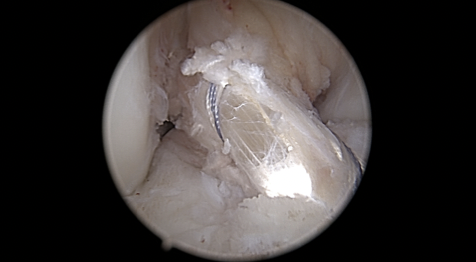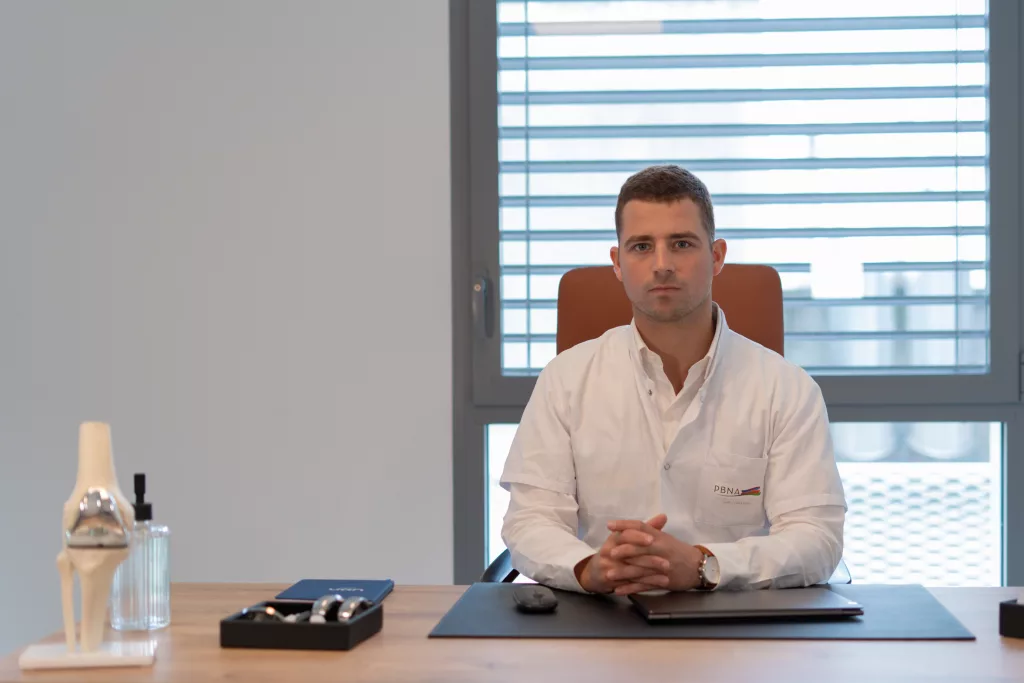Ligamentoplastie anterieure a Bordeaux
UOA Hanche Genou Bordeaux-Nord
Ligamentoplastie antérieure
Spécialiste du genou à Bordeaux
Votre chirurgien vous a proposé une chirurgie de reconstruction du ligament croisé antérieur (LCA) sous arthroscopie. Afin de prendre une décision en toute connaissance de cause, vous devez être informé(e) des
principes, des risques et des suites opératoires de cette intervention.
Le ligament croisé antérieur ou LCA est un ligament, constitué de fibres de collagène et tendu entre le tibia et le fémur. Il stabilise (avec les structures adjacentes : ménisques, capsule, ligament antéro latéral) le genou dans les gestes quotidiens et dans la pratique sportive.
Une blessure peut survenir lorsque ses capacités élastiques sont dépassées. Le genou devient douloureux, instable et gonfle.
Le but de l’intervention est de reconstruire ce ligament pour stabiliser votre genou et éviter l’apparition secondaire de lésions des ménisques ou du cartilage. Cette chirurgie se réalise au bloc opératoire sous arthroscopie (camera introduite dans le genou). C’est une technique mini invasive.
La ligamentoplastie est une reconstruction dite anatomique avec comme autogreffe les tendons des ischios jambiers laissés pédiculés au tibia et fixés dans des tunnels osseux.
Reconstruction du LCA
Chirurgie du ligament croisé antérieur à Bordeaux
Préparation à l’intervention
La chirurgie ambulatoire permet de rentrer à la clinique le jour de votre intervention et d’en sortir le soir même.
Votre parcours de soin pré et post opératoires est élaboré avec l’ensemble des équipes médicales et paramédicales pour vous assurer une prise en soin de qualité et sécuritaire.
Le service ambulatoire vous contactera la veille de votre intervention pour vous communiquer votre heure de convocation pour l’accueil administratifs.
Des étapes de dépilation, lutte contre les infections et de jeûne pré-opératoire sont obligatoires.
Vous pouvez vous référer au document ci-dessous.
Traitement de la Pathologie
UOA Hanche Genou Bordeaux-Nord
L'intervention
Le but de l’intervention est de remplacer votre ligament croisé antérieur rompu par une autogreffe prélevée directement sur votre genou (tendons des ischio-jambiers en 1ère intention; tendon quadricipital ou ligament patellaire dans les interventions de reprise) sous arthroscopie.
Vous restez dans le bloc opératoire entre 1h et 1h15 en comptant le temps d’installation, d’anesthésie et de chirurgie. La technique du Docteur Noailles a été publiée dans la revue internationale Arthroscopy Techniques. La technique de reconstruction du LCA employée par le Dr Sanchez est comparable. Les 2 techniques consistent en une reconstruction combinée du LCA et LAL.

1 Demi Tendineux laissé pédiculé au tibia, plié en 3 et faufilé avec du fil non résorbable : biocompatible pour constituer la greffe du LCA • 2 Tendon droit interne laissé pédiculé au tibia et faufilé à son extrémité • 3 Passage de la
greffe dans le tunnel tibial, dans l’articulation, puis dans le tunnel fémoral ; fixation de la greffe LCA par vis résorbables et par Endobutton (plaquette métallique).• 4 Passage de la greffe du tendon droit interne dans les tunnels
de la greffe du LCA puis dans le tunnel latéral pour constituer la greffe du LAL, fixation de celui-ci par vis résorbable.
L'arthroscopie
Cette intervention s’effectue sous arthroscopie (exploration de l’articulation par vidéo chirurgie) pour le temps articulaire. Un bilan méniscal et cartilagineux est systématiquement effectué avec traitement des éventuelles lésions. L’intervention comprend 4 à 5 incisions inférieures à 3 cm.
Le chirurgien réalise des tunnels à travers l’os du fémur et du tibia selon des paramètres très précis. Ces tunnels permettent le positionnement du nouveau ligament croisé antérieur. La fixation est assurée par un « endobutton » dans le tunnel fémoral, plaquette métallique de moins d’1cm visible sur la radiographie et par une vis résorbable dans le tunnel tibial.
A la fin de l’intervention, le genou est infiltré avec des anesthésiques locaux. Des pansements, une bande et une attelle de cryothérapie seront mis sur votre genou.
Vous serez conduit en salle de réveil où vous serez surveillé(e) jusqu’à votre réveil complet. Vous regagnerez votre chambre lorsque le réveil sera complet et votre douleur post-opératoire considérée comme bien contrôlée.

Vue arthroscopique de la greffe dans l’articulation
Risques et complication
L’arthroscopie a la réputation d’être une intervention bénigne, mais les statistiques font état de quelques complications qui, même si elles sont rares, préoccupent constamment l’équipe médicale.
- Risques anesthésiques ils sont expliqués lors de la consultation d’anesthésie préopératoire qui est obligatoire.
- Risques liés à la mise en place du garrot pré-opératoire le garrot peut être responsable de troubles cutanés ou neurologiques locaux, habituellement régressifs.
- Risques liés à l’utilisation du matériel étant donnée la petite taille de l’instrument, il peut arriver qu’un fragment de matériel se casse dans l’articulation.
- Risques liés à la technique chirurgicale dans la littérature internationale, ont été rapportés quelques cas exceptionnels de blessure des gros vaisseaux ou des nerfs situés à proximité de l’articulation, au cours du geste opératoire. Le chirurgien connaît parfaitement ces risques.
Risques post-opératoires
- L’infection de l’articulation est très rare. Une articulation présentant, dans les jours qui suivent l’intervention, un gonflement, des signes inflammatoires et s’associant éventuellement à une fièvre, doit faire évoquer cette complication. Elle nécessite un traitement en urgence.
- La thrombose veineuse ou phlébite du membre.
- L’hémarthrose (saignement intra-articulaire) se traduit par l’apparition brutale, rapide d’un épanchement sous tension qui peut être très douloureux.
- L’algodystrophie est une réaction douloureuse et enraidissante de l’articulation, d’origine inconnue, qui peut survenir après toute intervention chirurgicale.
- Le Flessum1 est une complication fréquente en lien avec un amyotrophie du vaste interne et une contracture réflexe des ischiojambiers. Il faut travailler la récupération complète de l’extension dès le post opératoire immédiat.
1 – Arthrogenic muscle inhibition after ACL reconstruction : a scoping review of the efficacy of interventions par B. Sonnery-Cottet, A. Saithna, B. Quelard, M. Daggett, A. Borade, H. Ouanezar, M Thaunat, W. G Blakeney
Suites post-opératoires
Vous aurez un premier rendez-vous de contrôle en télé consultation ou par entretien téléphonique avec l’infirmière travaillant en collaboration avec le Docteur Noailles et le Docteur Sanchez. Ce rendez-vous a lieu environ une semaine après votre chirurgie, il est gratuit.
Le rdv de contrôle avec le Docteur Noailles ou le Docteur Sanchez aura lieu au cabinet de consultation de Capnova entre 4 et 6 semaines après votre chirurgie.




